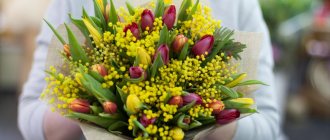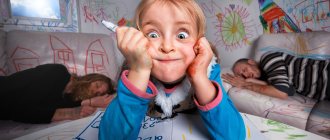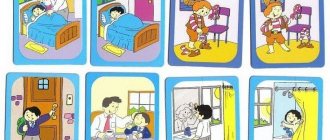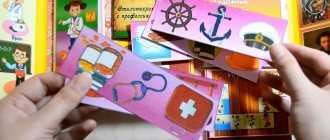Lesson - questions on the topic “Professions”
Lesson 4. Name the items needed for the profession:
- Programmer... (computer) - Astronomer... (spyglass) - Accountant... (calculator) - Geologist... (backpack) - Journalist... (recorder, pen and notepad) - Engineer...( drawing)
Lesson 5. Name the extra item:
- dough, baking dish, candy, bread (Baker) - needle, fabric, paper, scissors (Tailor) - stage, makeup, camera, flippers (Artist) - notes, stick, music, pen... (Conductor)
Lesson 6. Who drives what:
- drives a rocket - drives a train - drives a plane - drives a ship - drives a car - drives a tram, trolleybus, bus - drives a crane - drives an excavator - drives a tractor - drives a motorcycle
Lesson 7. True-false.
- a cleaner, who creates hats - a gardener works in a kindergarten - a carpenter sits at a table - a driver, who drives to different places - a cyclist, who steals bicycles - a blacksmith, who catches grasshoppers.
Lesson 8. Women's profession:
- boss... (boss) - artist-... - weaver... - translator... - waiter... - makeup artist...
Lesson 9. Who does what:
- works as a welder - carries luggage at stations - repairs watches - writes music - writes poetry - plays the piano
Exercise 10. Tell us about your parents’ profession.
On the topic: methodological developments, presentations and notes
Summary of an open event on the implementation of educational areas: “Labor”, “Cognition”, “Artistic creativity”, “Music” on the topic: “All professions are needed, all professions are important” in the senior group.
Goal: expand and enrich children’s ideas about professions.
Getting to know your surroundings. Middle group.
Abstract of GCD on manual labor in the senior group Educator: Brodnikova Lyubov Vladimirovna Topic: “All professions are important - all professions are needed.” Areas of integration: knowledge, fiction, art.
To form in children a generalized concept of “profession” through conversation, games, and assignments.
Source
MAGAZINE Preschooler.RF
Abstract of the educational activity “Journey into the world of professions” in the middle group of kindergartenCognition (Socio-communicative development, speech development, artistic and aesthetic development)
Goals: expand and clarify children’s ideas about the work of people of different professions; cultivate respect for working people, their activities and their results; develop attention, memory, thinking.
Software tasks:
Educational objectives: to consolidate children’s knowledge about professions, to show the importance of work in a person’s life; clarify, generalize and expand children’s knowledge about the characteristics of certain professions.
Developmental tasks: to promote the development of coherent speech, thinking, memory, curiosity, observation, to activate and enrich the children’s vocabulary with nouns, adjectives, verbs on the topic “Professions” .
Educational objectives: create conditions for nurturing respectful and kind attitude towards people of different professions; promote the development of the ability to work in a team.
Activation of the dictionary: phonendoscope.
Demonstration and handout material: multimedia equipment (pictures of professions and tools are shown on the projector), a board, magnets, pictures of vegetables and fruits, pots and jars, pictures of a drawn comb without teeth, pencils, steering wheel, “bus ” , first aid kit
Progress of the lesson
1. Organizational moment. Establishing emotional contact. [slide 1]
Invented by someone simply and wisely
When meeting, say hello: - Good morning!
Good morning to the sun and birds.
Good morning to smiling faces.
And everyone becomes kind and trusting
Good morning lasts until evening.
- Guys, let's wish each other good morning. (Children say hello.)
2. Announcing the topic of the lesson. Introductory conversation.
− Guys, every day in the morning your parents bring you to kindergarten, [slide 2] and they themselves go where, do you think? (Children's answers)
That's right, off to work. All people work. Do you know what your parents do? (Children's answers)
I work too. Tell me where and who do I work for? (Children's answers) Yes, I work in a kindergarten, and my profession is a teacher. [slide 3] What do you think a profession is? (Children's answers.)
A profession is work to which a person devotes his life; it is a person’s main occupation, his work activity. There are a lot of professions, all of them are very necessary and important for people. To get a profession, what do you think needs to be done? (Children's answers) That's right, you need to study well, know and be able to do a lot.
Educator: Guys, can’t you hear, it seems like someone is crying. Yes, this is our Kuzya. Kuzya, what happened?
Kuzya: When I grow up, I want to become a real Man, and Nafanya says that a real Man must have a profession, but I don’t know what that is (cries).
Children sit on the mat. They calm down Kuzya.
Educator: Yes, every adult has a profession. A profession is something that is done every day.
Kuzya: how complicated and incomprehensible everything is.
Educator - We will try to help you. Today we are going into the world of professions. And now I want to invite you to go on a journey through the world of professions. And on the trip, I suggest you go on the train, which is already waiting for us near the kindergarten. Take your seats and let’s hit the road. Go! [slide 4]
(Children's answers)
3. Introduction to the profession of “Cook” .
- And here is our first stop [slide 5].
(Children get off the “bus” and approach the screen)
Guys, where do you think we have come? What's the name of this place?
(Children's answers)
That's right, this is the kitchen - the room where food is prepared. What profession do people work here? (Children's answers)
That's right, cooks [slide 6]. This is a very important and necessary profession. There is a cook in kindergartens, schools, hospitals, factories, and cafes.
What does a cook do?
(Children's answers: cooks, fries, bakes, stews, cleans, cuts, etc.)
The cook knows how to prepare many tasty and healthy dishes, and knows how to bake cakes and pies. Guys, what does a chef need to work?
(Children’s answers: stove, pots, pans, ladles, etc.) [slide 7]
Let us help the chefs prepare soup and compote. And you watch, Kuzya, and learn! Tell me, what products can you use to make soup? (Children's answers: potatoes, onions, cabbage, etc.)
How to call all this, in one word? (Children's answers: vegetables)
Well done! This means that you and I will prepare soup from vegetables. And what products are the compote made from?
(Children's answers: apples, pears, etc.)
How to call these products in one word?
(Children's answers: fruits and berries) That's right! We will prepare compote from fruits.
Didactic game “Soup or compote?” On the tables there are pictures of vegetables, fruits and berries, pots and jars. Vegetables need to be put in a pan (soup), fruit and berries in a jar - in a jar (compote). At the same time, it is necessary to encourage children to explain their choice with the words: “An apple is a fruit, so compote is made from it” or “Onions are added to soup .
- Okay, so we cooked you a delicious soup and compote. Now let's go on our way, take your seats on the train. Go! [slide 8]
4. Introduction to the profession of “Hairdresser” .
- And here is the next stop [slide 9]. (Children get off the “train” and approach the screen)
Where do you think we ended up? (Children's answers)
That's right, this is a hairdresser. Tell me, who works here?
(Children's answers)
That's right, hairdresser [slide 10]. What does a hairdresser do at work? (Children's answers: cuts, dyes, does hair, etc.) [slide 11].
What tools does a hairdresser use in his work?
(Children’s answers: comb, scissors, hairdryer, etc.) [slide 12].
This is a very interesting and creative job, because a hairdresser does different hairstyles every day and makes people beautiful. People in this profession must be neat, polite and hardy, because they spend the whole day on their feet.
Guys, the hairdresser asked us for help, he works a lot, and the teeth on his combs are broken, let's help him and finish drawing the teeth on the combs. Shall we help? Then go to the tables, take markers and finish drawing the teeth..
...the teeth are vertical lines of the same length.
(The teacher invites the children to draw combs.)
Drawing “Add teeth to the comb . Children draw “comb teeth” - vertical lines of the same length on a drawn blank.
Educator: - Well done, and they coped with this task, helped the hairdresser fix all the teeth, now he can continue to work.
Kuzya: how much you learn about professions!
5. . Physical education minute. [slide 13].
Game: “Who is doing what?” Here is a list of professions.
Kuzya - I can handle this task myself.
Teacher - are you sure? Let us help you a little. Let's stand in a circle. If you say it correctly, the children will clap, if you say it incorrectly, they will stomp.
The doctor gives an injection.
The artist waters the flowers.
The hairdresser washes clothes.
A fireman extinguishes potatoes.
The driver is painting the walls.
Educator - you mixed everything up, let's play a game with the ball “Who is doing what?” and you will figure everything out.
Kuzya names his profession, and the one to whom he throws the ball answers.
1. Doctor. makes a compress, gives medicine, applies ointment, looks at the throat, applies a bandage, plaster.
3. The seller ...counts the money, weighs the goods, sells, packs.
4. Hairdresser...cuts, dries hair, washes, does hair, dyes hair.
5. A fireman...puts out a fire, saves people, stocks up on water, goes to the rescue.
6. The cook...fries cutlets, cooks compote, makes vinaigrette, bakes pies.
7. The driver...drives cars, changes tires, transports people, makes repairs.
8. The postman ... brings letters, newspapers, magazines, puts them in the mailbox, carries telegrams, walks with a large bag.
Well done, you completed this task, Kuzya, did you remember everything?
- Let's move on. Go! [slide 14].
6. Introduction to the profession of “Doctor” .
- And here is the next stop [slide 15]. (Children get off the “train” and approach the screen.)
Where do you think we ended up?
(Children's answers)
That's right, this is a clinic (hospital). Tell me, what profession do people work here? (Children's answers)
That's right, doctors [slide 16].
What does a doctor do? (Children's answers: treats, gives injections, writes prescriptions, measures, listens, etc.)
What does a doctor need to work? (Children's answers: first aid kit, thermometer, bandages, syringe, etc.) [slide 17].
Do you know what this tool is called and what it serves?
(Children's answers)
This instrument is needed to listen to your internal organs: heart, lungs. It's called a phonendoscope. [slide 18].
(Children repeat the new word.)
The profession of a doctor is a very important and necessary profession.
Tell me, what would happen if we didn't have doctors? (Children's answers)
That's right, if there were no doctors, people would often get sick and could die from various diseases. Doctors are different. What doctors do you know?
(Children's answers)
That's right, a pediatrician treats children, a surgeon performs operations, a dentist treats teeth, an ophthalmologist checks vision. Doctors must be brave, determined and strong. Now I suggest you play a game.
Didactic game . ” Kuzya helps! There are various objects on the table, from which children need to choose the tools the doctor needs for his work.
Educator: Do you understand, Kuzya?
Kuzya: Yes, I learned a lot today! And most importantly, I realized that I need to study a lot.
Result:
− Our journey to the land of professions is coming to an end. What professions did we meet today? (Children's answers)
We will definitely continue our trip next time, because there are a lot of professions. And all of them are very important and needed by people. Now let's take a course back to kindergarten.
(Children get on the “train” [slide 19] and return to kindergarten [slide 20])
Kuzya - Yes... there are so many professions in the world. I learned so much today. Guys, we completed all the tasks, for this I thank you, and I give you these coloring books!
Say goodbye to Kuzya!
Educator: Guys, thank you for your efforts, you all did well today!
| Next > |
An example of a drawing lesson summary on the topic “Professions”
The main purpose of such a summary is to teach children plot drawing. To do this, you need to depict people in motion and create interesting compositions.
Note! An equally important factor is the development of compositional skills (draw across an entire sheet of paper, convey proportional and spatial relationships between objects)
Lesson Objectives
Main objectives of the lesson:
- form ideas about the activities of a particular profession, tools;
- to instill in children a sense of appreciation and respect for the work of adults;
- continue to introduce children to dangerous objects for the sake of life and health safety;
- replenish children's vocabulary;
- consolidate the names of familiar professions, as well as objects and tools.
Creative corner
Developmental tasks:
develop the ability to construct complete answers, listen carefully (communication); develop memory, attention, logical thinking (cognition); develop initiative, the ability to act in a team (socialization).
Step-by-step drawing for beginners - lessons for children
Educational tasks:
- develop respect for people of different professions;
- cultivate feelings of responsiveness and mutual assistance.
Abstract of GCD for drawing on the topic “Adult Labor”
Fatimet Yahutl
Abstract of GCD for drawing on the topic “Adult Labor”
Abstract of GCD on aesthetic development. Drawing .
Topic: " Adult Labor "
.
Expand your understanding of professions. Introduces the profession of a janitor.
Cultivate a desire to provide assistance and pay attention to those in need. Enrich cognitive knowledge (familiarity with tools, objects of work of a janitor )
.
Generalize knowledge about the required professions. Show the importance of the janitor profession, cultivate a respectful attitude towards working .
Materials: broom, broom, paints, album sheets, jars of water, brushes.
Riddles on the theme “Professions”
He corrects mistakes, He reflects with us. Teaches us to write, read, What to call our profession? (Teacher)
The cabin is like a home to him, He is familiar with the roads. The traffic light flashes for him, And says that he... (Chauffeur)
The one who rushes in a car with blue flashing lights, who extinguishes the fire with water, pouring hoses. (Firemen)
A man stands guarding the law. Nice uniform on him, pistol in a holster. (Police officer)
On Earth we have various disturbances, hurricanes, explosions, storms and earthquakes. We didn’t waste time, the Ministry of Emergency Situations... (Rescuers)
He is not afraid of flying, he flies planes in the sky. At the helm all year round, By profession... (Pilot)
You went to the circus with your family and laughed heartily. The hall is full of delight, Because he came out... (Clown)
Knows all the laws, constantly performs. And he is not an Artist at all, His profession is... (Lawyer)
The dining room menu for lunch includes cutlets, soup and vinaigrette. The guys eat, don’t argue, because the best cooks... (Cook)
Goes on a flight, But not a pilot, not a pilot. He will land on the planet, He is in a big, big rocket. (Astronaut)
He guards the border, the borders of our country. So that the enemy cannot break through, so that there is no trouble. (Border Guard)
When he was studying, he was a cadet, He was taught to fight, to defend his native country. Now the shoulder straps are on his shoulders, and he holds the rank of lieutenant. (An officer)
We receive a letter, Who brings it to us? (Postman)
Whoever is sick, He will help and heal. A man in a white robe is busy with a very important matter. (Doctor)
The children were brought to kindergarten, and the parents left. You kids shouldn’t have cried, they love you... (Teachers)
If we need books, We go to the temple of silence. You can learn a lot if you like to read. Well, to discover a magical way, Help us... (Librarian)
He boldly wields scissors skillfully, To keep your hair in order, He will style your hair. And with the help of a comb, a good hairstyle. (Hairdresser)
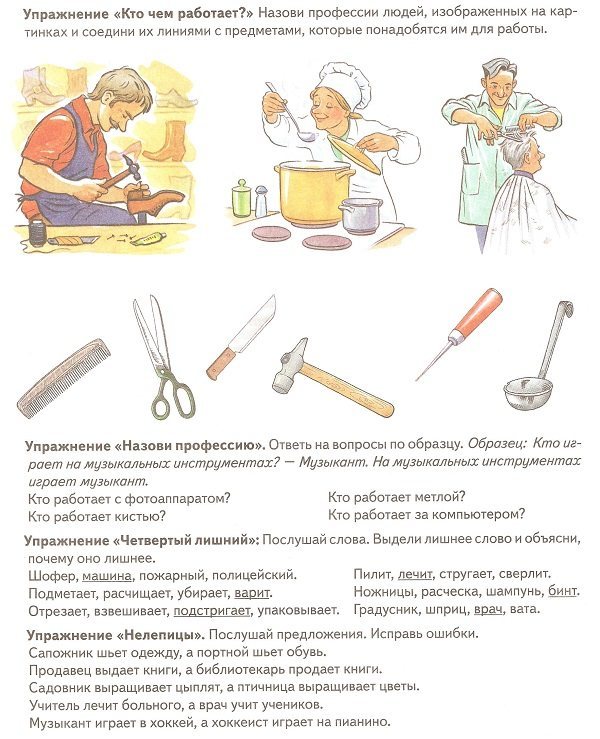
Practical part of the lesson, drawing a profession
In order for the drawing of a profession to be useful in the older group, and for the children to find it interesting, the teacher needs to adhere to a certain course.
First, he needs to find poems that are dedicated to professions and drawing. At the end, the teacher needs to ask the children a question: What professions can you name? At the same time, they should not name items that have already been previously voiced in the poem. Next you need to organize a simple game. The teacher takes the ball, throws it, the one who catches it guesses a riddle related to human activity. Or you can show children pictures so that they visually understand who the profession is in the picture. Finally, the teacher must praise the children. The third stage will be the actual drawing. The teacher once again shows pictures of people so that the children can understand what they look like, how their torso and arms are located
It is necessary that the teacher draw the children’s attention to all the details depicted.
The guys start drawing, the teacher does not forget to observe and help those who ask for help.
Drawing steps:
- the teacher explains how to draw the foreground and background;
- what colors may predominate in a particular profession;
- shows the technique of drawing people;
- Based on all that has been said, he invites the guys to try to draw themselves in the profession in which they see themselves.
This same technique can also be used in a drawing lesson, but also in a preparatory group on the topic of Professions in kindergarten.
To make drawing more fun for the children, you can turn on music quietly in the background, or the teacher can sing a few songs dedicated to this topic.
Joint activities will also help parents and parents get even closer, learn to interact and understand each other.
An example of a drawing lesson summary on the topic “Professions”
The main purpose of such a summary is to teach children plot drawing. To do this, you need to depict people in motion and create interesting compositions.
Note! An equally important factor is the development of compositional skills (draw across an entire sheet of paper, convey proportional and spatial relationships between objects)
Lesson Objectives
Main objectives of the lesson:
- form ideas about the activities of a particular profession, tools;
- to instill in children a sense of appreciation and respect for the work of adults;
- continue to introduce children to dangerous objects for the sake of life and health safety;
- replenish children's vocabulary;
- consolidate the names of familiar professions, as well as objects and tools.

Creative corner
Developmental tasks:
develop the ability to construct complete answers, listen carefully (communication); develop memory, attention, logical thinking (cognition); develop initiative, the ability to act in a team (socialization).
Exercises for developing memory in children in kindergarten classes
Educational tasks:
- develop respect for people of different professions;
- cultivate feelings of responsiveness and mutual assistance.
Summary of GCD in the preparatory group on the topic Professions
Summary of GCD in the preparatory group
Abstract of educational activities for children of the preparatory group (6-7 years old) on the topic “Different types of profession”
Integration of educational areas “Cognition”, “Communication”, “Artistic creativity”, “Physical education”. Goal: expanding children's knowledge about the variety of professions. Objectives: to consolidate children’s knowledge about different types of profession, to show that people of different professions are closely connected with each other and do one common thing together; introduce the creative profession of an artist; develop children's speech, expand their vocabulary of words: landscape, still life, portrait; cultivate interest and respect for people of different professions. GCD progress: - Have you ever thought about the fact that all adults have one profession or another and work every day? — How do you understand the word “profession”? Right. This is the main occupation, work activity to which a person devotes his life. - Let's remember what professions there are. Right. Educator, teacher, doctor, salesman, driver, builder, policeman. There are many professions! Who will give the book? Librarian. Who bakes bread in the bakery? Baker. The letter will be delivered by the postman, and the cook will cook us some broth. The teacher will teach you everything - teach you how to count and write. There are many professions, you can’t count them all in poetry! To master any profession, you need to develop certain character traits. Many professions require a person to be able to communicate, listen carefully to people, maintain a friendly and friendly tone, and show kindness and responsiveness. — Try to name professions that require a person to show courage, the ability to instantly assess the situation and make the right decision. Policeman, rescuer, firefighter. — Tell me, what unites them? (ability to communicate, listen carefully to people, maintain a friendly and friendly tone, show kindness, responsiveness, patience)
.
— Tell me, what would you like to become when you grow up? I think when you grow up, you will find something you like! — There are also creative professions. To become an artist, writer, artist, musician, you need to have talent and a good imagination. — Today we will talk about people who have an amazing ability to draw. Such people are called artists. This is a very important profession, artists draw pictures, depict what they see and introduce us. With what we don’t notice, Elastic plantain, And Ivan’s brushes of tea, And the blue of the river, And the golden field, All the beauty of the earth. The artist will reveal it to us! - Tell me, you like to draw! — What do you draw with and on what? Our distant ancestors also loved to draw. Although they had no paper, no canvas, no pencils. Stone Age people painted their designs on the smooth surfaces of large stones and rocks. With amazing accuracy and expressiveness they depicted wild animals: deer, wild boars, mammoths, as well as hunting scenes. They carved their drawings with stone teeth and axes, sometimes using natural paints - the juices of some plants. The creations of these artists have survived to this day and are stored in museums. We can safely say that art came to us from ancient times and was born along with man. People at all times wanted to reflect in drawings the most vivid impressions of life, to depict the world around them. — Tell me, what else can you use to draw besides pencils and felt-tip pens? (paints, gouache, crayons)
.
Most often, artists depict their native nature in their paintings: meadows, fields, rivers, rainbows - such paintings are called “Landscapes”. Pencil, pencil! Draw me a landscape. Stroke after stroke - the result is an old house, a front garden and a porch, and in the distance - meadows and a river. Admire the landscape, Do you recognize our village? - I think many of you have seen the painting “The Rooks Have Arrived” by A.K. Savrasova, “Birch Grove” by A.I. Kuindzhi. (look at the paintings)
- Have you tried the delicious sweets “Teddy Bear”?
Don't be surprised, because we're talking about artists? The candy wrappers depict a mother bear with her cubs. This is a reproduction from a painting by the wonderful artist I.I. Shishkin "Morning in a pine forest." — What do you think portrait artists depict on their canvases? (portraits of people)
. - Look, artists not only draw people, but also try to convey the appearance of a person, reveal his character, show his mood. I have a pencil, a piece of paper and gouache. I will draw a portrait of Little Alenka: Jacket, scarf and beret With a blue pompom. I will draw a forehead and nose, a strand of fluffy hair, long eyelashes. What
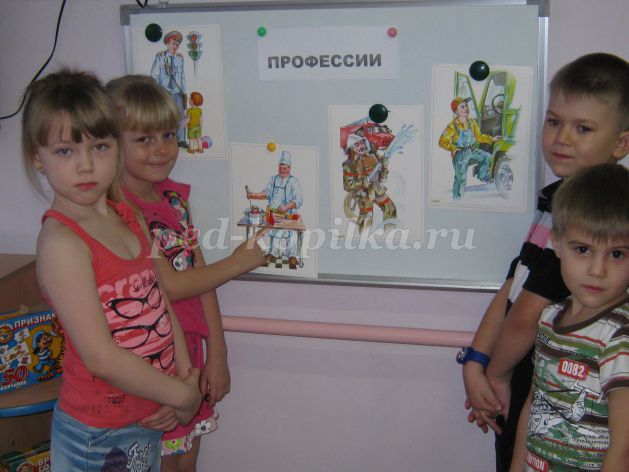
Physical Education Minute Also on their canvases, artists depict household items: fruits, vegetables, showing us their beauty - such a picture is called “Still Life”. I will beautifully arrange a bunch of grapes, pears, and plums on a saucer. I'll open my notebook and start drawing fruits. First, I’ll draw plums with a lilac-pink tint. Then a fragrant pear side, in which ripe juice ferments, then transparent grapes, preserving the southern aroma. The still life turned out successful, and I’m proud of my drawing! — Do you like looking at bright, elegant picture books? - Why do you like them? Artists who decorate children's books with illustrations are called “Illustrators.” - Let us also be artists today. Go to the table and take the material that you will need for your work. - Think about what you want to draw? “Still Life”, “Portrait”, “Landscape”. When you finish your work, we will arrange an exhibition of your works, and you will tell us what you drew. At the end of our lesson, I want to give you all colored pencils so that your drawings will always be bright and colorful and will please not only you, but also all the people around you.
We recommend watching:
Summary of the GCD for FEMP in the preparatory group Traveling around the country Mathematics Summary of the GCD for the preparatory group on the topic “Paintings by artists” Summary of a recreational and educational lesson on traffic rules in the preparatory group Synopsis of the GCD for FEMP in the preparatory group on the topic “Visiting Professor Aquarius”
Similar articles:
Summary of educational activities on cognitive and speech development in a speech therapy group preparatory to school
Summary of educational activities on cognitive and speech development for a speech therapy group preparatory to school
Summary of GCD with elements of non-traditional types of gymnastics in the preparatory group for the educational field “Physical Education”
Outline of GCD in the preparatory group
Summary of educational activities on cognitive development in the preparatory group
Fine arts lesson on the topic “Professions” in the middle group of kindergarten
To begin with, the teacher selects the appropriate game, for example, “Determine a person’s profession.” Its main goal is to teach how to distinguish between people’s positions based on their special clothing.
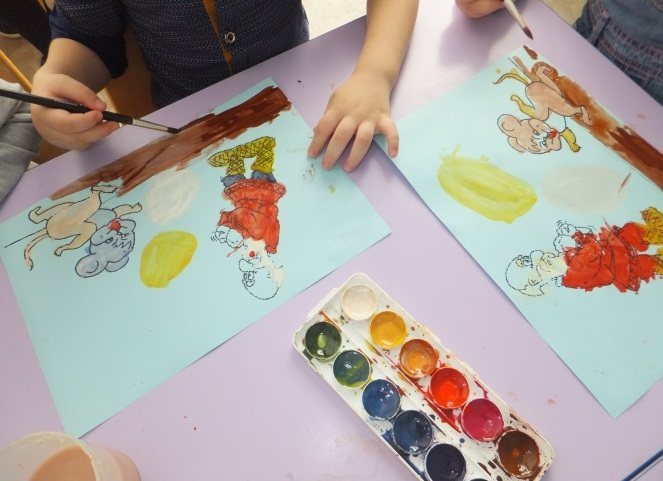
Fine arts lesson on the topic “Professions” for children of the middle group
Note! The teacher should ask the children what kind of clothing is needed for a cook, a policeman, a sailor, or a salesman. The game is played with items of clothing
When considering several professions at once, it is advisable to use coloring books to make it easier for children to learn the material. They will color people in different clothes. At the end of the lesson, the middle group children, as a rule, show each other their pictures. These actions are carried out to:
- expand and clarify children’s ideas about the work of people of different callings;
- teach kids to identify the names of professions based on the actions depicted;
- develop spatial representations: left, right, up, down, behind, in front;
- teach children to count a given number of objects and compare their totality;
- compare objects by height;
- consolidate knowledge about geometric shapes, vegetables or fruits;
- develop the ability to complete sentences using words and phrases related to a person’s specific profession;
- use new words: hairdresser, builder, driver, salesman, painter, cook, doctor;
- strengthen the ability to draw and paint with colored pencils;
- develop curiosity;
- cultivate respect for people, their activities, and their results.
Summary of a lesson on speech development in a preparatory correctional group on the topic “Professions of People”
Goals:
- expand and specify ideas about people’s professions.
- fix in speech a noun with the general meaning of “profession”.
- clarify and expand vocabulary on this topic.
- improve the grammatical structure of speech (exercise in the formation of adjectives from nouns, agreement of numerals with nouns)
- improve skills in constructing simple and complex sentences.
- develop speech activity, dialogical speech (through answers to questions, dialogue)
- develop phonemic processes, sound analysis and synthesis skills.
- correct auditory attention, memory, thinking.
- develop oral coherent speech (through the construction of grammatically correct phrases and sentences)
- cultivate motivation for learning and emotional feelings.
Equipment:
- subject pictures (doctor, cook, teacher);
- items for the organizational moment - a hammer, a ladle, thread with a needle, a brush;
- conductor's bag (with tickets), steering wheel, "coin" mugs, doctor's coat, salesman's apron;
- thermometer, ruler, listening ear, glasses, syringe, needle, vitamins, candy, potion, jam, spatula, spoon, toy from the puppet theater - a puppy;
- game “shop”, in the store there are toys, books, food, dishes;
- a dollhouse with the inscription “school”;
- ball.
Progress of the lesson
I. Organizational moment.
Children enter the office. There are various objects on the carpet (hammer, scissors, needle and thread, ladle)
- Look, what a mess! Someone left objects. Name them. I think the carpenter left the hammer. Who left the scissors? etc.
These items are needed by people of different professions.
II. Subject message.
— Today in class we will go on a journey through the “city of professions” in order to learn even more about professions and better remember their names.
III. Introduction to the topic.
- And what you and I will travel on, you will find out if you guess the riddle: “What a miracle - the house is moving!”
- And there are so many people in it! Wears rubber shoes
- And it runs on gasoline!” (bus)
Right! We'll go by bus.
IV. Work on the topic.
- 1) Consolidation of the names and ideas about the professions of DRIVER and CONDUCT.
- —Who drives the bus? (chauffeur)
- Who else works on the bus? (conductor)
- Children are assigned to the role of driver and conductor
- -Who are you now? (passengers)
Children use chairs to build a “bus”
— To ride the bus, we have to pay the fare. Take coins (I give each “passenger” 10 coins)
. How much does a bus ticket cost? (6 rubles) How many coins should we give to the conductor? (6 coins). Count out the coins, and the conductor will check whether you paid for the fare correctly and hand out tickets.
- - Well, everyone has paid for the fare, the bus can leave.
- — Suddenly the bus tire got punctured. (pronouncing the sound sh-sh-sh-sh)
- — Let's help the driver pump up the tire. (pronouncing the sound s-s-s-s)
- — The bus drove onto the wet road. (pronouncing the syllables sha-shu-sho-shi)
- Listen. A train whistle is heard in the distance. (pronounce the syllable on one exhalation tu-tu-tu-tu)
“Suddenly, a car honked its horn very close to us. (pronounce the syllable with one exhalation beep-bee-bee)
- Now look out the window, to the right. The sun shines so brightly right into our eyes. Close your eyes tightly. - Look to the left. Passers-by smile at us. Let's smile at them too. Give them a wave.
- Well, the bus stopped and we arrived. We get off the bus.
2) Consolidating the name and ideas about the profession of COOK.
The children come to the first table. On the table, turned away from them, is a picture of a cook.
— Do you feel how delicious it smells here: fresh buns, fried cutlets, aromatic soup? Have you guessed who we came to visit? (We came to visit the cook.)
— What does the cook do? (The cook cooks, cooks....)
- Right! The cook prepares different delicious dishes.
Questions for children based on the drawings they have drawn on the topic “Professions”
At the end of the lesson, the teacher can ask the children several thematic questions:
- What profession did you draw?
- What are the features of your chosen profession?
- Why did you choose this particular activity? Why do you like her?
- What will you do in this position?
Note! Questions can be replaced with riddles or proverbs and sayings about work. After asking questions, the teacher must say that the children did a good job, drew excellent pictures, and that they gained a lot of new knowledge and skills throughout the lesson.
After asking questions, the teacher must say that the children did a good job, drew excellent pictures, and that they gained a lot of new knowledge and skills throughout the lesson.

The final version of the drawing respecting the composition
All consistent outline plans should help children not only learn to draw and maintain composition, but also learn more about professions, their characteristics, that every work is worthy of respect and that there is no bad work.
Note! Leading questions, riddles, fairy tales, proverbs and sayings will help consolidate their knowledge. Lessons can be diversified with small theatrical performances that will help children better see the profession, and then, in fact, draw it on paper
Lessons can be diversified with small theatrical performances that will help children better see the profession, and then, in fact, draw it on paper.
The teacher should help children: develop their abilities, have conversations, and also more often organize creative drawing classes dedicated to a particular topic, since the Federal State Educational Standards system of preschool educational institutions is aimed at ensuring that a preschooler receives a sufficient amount of knowledge and skills before going to first grade.
Lesson notes for the middle group “Who is an artist?”
What feelings does the painting evoke?
Are you happy or sad looking at her?
What is the most important thing in the picture?
Describe the children's faces.
What did the artist V. Perov want to say with his work?
Educator:
Let us create our own work too! Let's think about what will be the main thing and how we can arrange the remaining objects so that we get a real picture. (The teacher conducts the didactic game “Make a Picture”)
Educator: Guys, do you think it’s difficult to be an artist? (Children's answers).
Educator:
Yes, to create their works, artists travel a lot, observe, and fantasize. Only then do they draw what they especially liked. Very often the artist does not have time for rest and entertainment. But you and I know that you need to take care of your health. If you are tired, you need to rest a little. I suggest doing exercises.
Physical education minute
I have always dreamed of becoming an artist, the gesture of dreaming, resting my head on my hand.
That's why I drew everywhere. Drawing in the air with an outstretched hand
.
With a pen on a piece of paper like this Drawing in the air with your hand, at chest level.
With a brush on the canvas like this Drawing in the air with your hand extended forward.
Pencil on the desk Drawing in the air with your hand, at chest level.
And chalk on the asphalt. Drawing in the air with your hand, at floor level
.
Boots on the snow, Foot drawing on the floor.
I skate on the ice with skates. Drawing on the floor with your foot.
On the sand with a twig, Drawing in the air with an imaginary twig on the floor.
On the board with a nail. Drawing in the air with an imaginary nail.
Educator:
To make the painting truly beautiful, the artist, like a real wizard, selects colors and mixes them. Let us also try to mix paints and get new shades. But we will do this not on a palette, but in magic jars. (The teacher conducts an experiment “Mixing colors”).
Educator:
But to paint a picture, the ability to mix paints is not enough. An artist must be able to peer into the world around him, listen in order to notice everything and draw beautifully. Then the lines, dots and spots will create real magic. See what can come out of ordinary lines, dots and spots. (The teacher shows and explains drawing from a spot, line, point).
Educator:
And now I will touch each of you with my brush and turn you into real artists. (The teacher touches each child with a brush, calling his name).
Educator:
Now, like real artists, you can draw your own miracles. Take your materials and turn the shapes on your sheets into something fabulous and unusual. And when you finish your work, we will all try to guess what you did together. (Music plays. Children draw on their own, the teacher helps children who have difficulties with guiding questions.).
Progress of the lesson.
V.: - Guys, look how warm it is outside. Let's hold hands and transfer our warmth to each other. Well done! (Children hold hands and form a circle.)
IN
: Attention! Let's get ready to work! (Children should stand in a circle, facing the teacher). IN
:Look around and say:What time of year is it now? (spring)
V.: Look around and say: What time of year is it now? (spring)
. After what time of year does spring come? (after winter)
. Winter is over, spring has come, and everything around has changed. How has the area changed since spring arrived? (The snow has melted, puddles have appeared, the trees are coming to life, leaves will soon appear, the sky is blue, clear, the sun is shining brightly, it’s warm outside)
Do you want to take a walk on the property? (YES)
. Why? (It’s warm outside, the sun is shining brightly, the area is clean and beautiful)
.Guys, early this morning, when I was going to work, I saw this object on our territory.
What do you think this is? (broom)
Guess who we'll be talking about today? (About the janitor)
He will wake up at dawn
The snow will be cleared in the yard.
All paths will be swept
And the ice will sprinkle sand.
